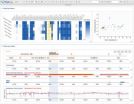(Press-News.org) BOSTON –– A large DNA analysis of people with and without pancreatic cancer has identified several new genetic markers that signal increased risk of developing the highly lethal disease, report scientists from Dana-Farber Cancer Institute.
The markers are variations in the inherited DNA code at particular locations along chromosomes. Several of these variations in the DNA code were identified that influence an individual's risk for pancreatic cancer.
The discovery of these markers – along with four that were previously identified is important for several reasons, said Brian Wolpin, MD, MPH, first author of the report published online by Nature Genetics. One is that further study of these DNA variants may help explain on the molecular level why some people are more or less susceptible to pancreatic cancer than the average person. A second is the potential to identify people at increased risk who then might be candidates to undergo MRI or ultrasound scanning to look for early, treatable pancreatic tumors.
"Currently there is no population screening program for pancreatic cancer, which in 80 percent of cases is discovered when it's too late to allow curative surgery – the cancer has already spread," said Wolpin.
The only healthy individuals currently screened for pancreatic cancer are members of high risk families due to multiple family members with pancreatic cancer. "But the field has been struggling to find factors that can identify people at highest risk in the general population, when a strong family history is not present," Wolpin said.
The study findings represent analyses of DNA from 7,683 patients with pancreatic cancer and 14,397 control patients without this cancer, all of European descent, from the United States, Europe, Canada, and Australia. The scientists used sequencing technology to examine more than 700,000 sites of the genome known to have single nucleotide polymorphisms (SNPs) – differing versions of a single letter of DNA code. These variations can alter the expression of a gene or the content of its message, and the researchers looked for variants that were associated with the risk of having pancreatic cancer. Research of this type is called a genome-wide association study, or GWAS.
Wolpin said the results confirmed the presence of four risk-associated SNPs that had been identified in a previous, smaller GWAS study. In addition, five new risk markers were discovered and a sixth that was of borderline statistical significance.
The risks linked to each SNP or marker were largely independent and additive, so that they may have utility in future attempts to identify individuals in the general population at higher risk for pancreatic cancer. The average lifetime risk of pancreatic cancer is 1.5 percent.
The long-term goal is to create a "risk stratification tool" that could be used in primary care practice to identify individuals who should undergo screening for pancreatic cancer with tests such as ultrasound or MRI.
INFORMATION:
The report includes authors from around the world, and includes several senior authors, one of whom is Charles Fuchs, MD, MPH, of Dana-Farber.
The project, known as PanScan III, was funded by numerous sources, including the National Cancer Institute of the National Institutes of Health under contract number HHSN261200800001E and the Lustgarten Foundation.
About Dana-Farber Cancer Institute
Dana-Farber Cancer Institute, a principal teaching affiliate of Harvard Medical School, is world renowned for its leadership in adult and pediatric cancer treatment and research. Designated as a comprehensive cancer center by the National Cancer Institute (NCI), it is one of the largest recipients among independent hospitals of NCI and National Institutes of Health grant funding. For more information, go to http://www.dana-farber.org.
Study finds new genetic risk markers in pancreatic cancer
Discovery could lead to future screening tests
2014-08-03
ELSE PRESS RELEASES FROM THIS DATE:
Rare developmental disorder linked to tumor-suppressing protein, Stanford researchers find
2014-08-03
CHARGE, which affects 1 in 10,000 babies, is an acronym whose letters stand for some of the more common symptoms of the condition: coloboma of the eye, heart defects, atresia of the choanae, retardation of growth and/or development, genital and/or urinary abnormalities, and ear abnormalities and deafness.
Originally, the researchers were examining the tumor-suppressive properties of the protein, called p53, not investigating developmental disorders. But when a mouse model developed a strange set of deficiencies, the researchers followed a trail of clues that led them ...
UMD researchers develop tool to better visualize, analyze human genomic data
2014-08-03
Scientists at the University of Maryland have developed a new, web-based tool that enables researchers to quickly and easily visualize and compare large amounts of genomic information resulting from high-throughput sequencing experiments. The free tool, called Epiviz, was described in a paper published online on August 3, 2014 in the journal Nature Methods.
Next-generation sequencing has revolutionized functional genomics. These techniques are key to understanding the molecular mechanisms underlying cell function in healthy and diseased individuals and the development ...
Making sense of scents
2014-08-03
For many animals, making sense of the clutter of sensory stimuli is often a matter or literal life or death.
Exactly how animals separate objects of interest, such as food sources or the scent of predators, from background information, however, remains largely unknown. Even the extent to which animals can make such distinctions, and how differences between scents might affect the process were largely a mystery – until now.
A new study, described in an August 3 paper in Nature Neuroscience, a team of researchers led by Venkatesh Murthy, Professor of Molecular and Cellular ...
Clues to curbing obesity found in neuronal 'sweet spot'
2014-08-02
New Haven, Conn. -- Preventing weight gain, obesity, and ultimately diabetes could be as simple as keeping a nuclear receptor from being activated in a small part of the brain, according to a new study by Yale School of Medicine researchers.
Published in the Aug. 1 issue of The Journal of Clinical Investigation (JCI), the study showed that when the researchers blocked the effects of the nuclear receptor PPARgamma in a small number of brain cells in mice, the animals ate less and became resistant to a high-fat diet.
“These animals ate fat and sugar, and did not gain ...
Pepper and halt: Spicy chemical may inhibit gut tumors
2014-08-02
Researchers at the University of California, San Diego School of Medicine report that dietary capsaicin – the active ingredient in chili peppers – produces chronic activation of a receptor on cells lining the intestines of mice, triggering a reaction that ultimately reduces the risk of colorectal tumors.
The findings are published in the August 1, 2014 issue of The Journal of Clinical Investigation.
The receptor or ion channel, called TRPV1, was originally discovered in sensory neurons, where it acts as a sentinel for heat, acidity and spicy chemicals in the environment. ...
Study reveals one reason brain tumors are more common in men
2014-08-02
New research at Washington University School of Medicine in St. Louis helps explain why brain tumors occur more often in males and frequently are more harmful than similar tumors in females. For example, glioblastomas, the most common malignant brain tumors, are diagnosed twice as often in males, who suffer greater cognitive impairments than females and do not survive as long.
The researchers found that retinoblastoma protein (RB), a protein known to reduce cancer risk, is significantly less active in male brain cells than in female brain cells.
The study appears Aug. ...
Understanding how neurons regulate metabolism in response to a high-fat diet
2014-08-02
The brain plays a central role in regulating appetite and whole-body metabolism. A protein known as PPARγ is important in the brain's control of food intake and body weight, but the identity of the neurons regulating this process has been unclear. A new study in the Journal of Clinical Investigation demonstrates that PPARγ activity in a type of neuron known as pro-opiomelanocortin (POMC) neurons is critical in mediating the response to high-fat diet. Sabrina Diano and colleagues at Yale University School of Medicine found that mice lacking PPARγ specifically ...
New research characterizes in-flight pediatric deaths
2014-08-01
CLEVELAND, Ohio – In a first-of-its-kind study, researchers at University Hospitals Rainbow Babies & Children's Hospital (UH Rainbow) found that lap infants may be at greater risk for death on a commercial airline flight. The study analyzed pediatric medical emergencies on flights worldwide between January 2010 and June 2013 and found 90 percent of deaths occurred in children under the age of 2.
The study was conducted in partnership with MedAire to characterize the rare event of an in-flight pediatric fatality onboard commercial airline flights worldwide. Through a ...
Best evidence yet for coronal heating theory detected by NASA sounding rocket
2014-08-01
VIDEO:
NASA's EUNIS sounding rocket mission spotted evidence to explain why the sun's atmosphere is so much hotter than its surface.
Click here for more information.
Scientists have recently gathered some of the strongest evidence to date to explain what makes the sun's outer atmosphere so much hotter than its surface. The new observations of the small-scale extremely hot temperatures are consistent with only one current theory: something called nanoflares – a constant ...
Scientists solve 2,000-year-old mystery of the binding media in China's polychrome Terracotta Army
2014-08-01
Even as he conquered rival kingdoms to create the first united Chinese empire in 221 B.C., China's First Emperor Qin Shihuang ordered the building of a glorious underground palace complex, mirroring his imperial capital near present-day Xi'an, that would last for an eternity.
To protect his underworld palaces, the First Emperor issued instructions that his imperial guard be replicated, down to the finest details, in red-brown terracotta clay, poised to do battle. Thousands of these imperial guards were initially discovered in 1974; some contained patches of pigment that ...
LAST 30 PRESS RELEASES:
Sports injuries sustained during your period might be more severe
World's first successful 2 Tbit/s free-space optical communication using small optical terminals mountable on satellites and HAPS
Can intimate relationships affect your heart? New study says ‘yes’
Scalable and healable gradient textiles for multi‑scenario radiative cooling via bicomponent blow spinning
Research shows informed traders never let a good climate crisis go to waste
Intelligent XGBoost framework enhances asphalt pavement skid resistance assessment
Dual-function biomaterials for postoperative osteosarcoma: Tumor suppression and bone regeneration
New framework reveals where transport emissions concentrate in Singapore
NTP-enhanced lattice oxygen activation in Ce-Co catalysts for low-temperature soot combustion
Synergistic interface engineering in Cu-Zn-Ce catalysts for efficient CO2 hydrogenation to methanol
COVID-19 leaves a lasting mark on the human brain
Scientists use ultrasound to soften and treat cancer tumors without damaging healthy tissue
Community swimming program for Black youth boosts skills, sense of belonging, study finds
Specific depressive symptoms in midlife linked to increased dementia risk
An ‘illuminating’ design sheds light on cholesterol
Who is more likely to get long COVID?
Study showcases resilience and rapid growth of “living rocks”
Naval Research Lab diver earns Office of Naval Research 2025 Sailor of the Year
New Mayo-led study establishes practical definition for rapidly progressive dementia
Fossil fuel industry’s “climate false solutions” reinforce its power and aggravate environmental injustice
Researchers reveal bias in a widely used measure of algorithm performance
Alcohol causes cancer. A study from IOCB Prague confirms damage to DNA and shows how cells defend against it
Hidden viruses in wastewater treatment may shape public health risks, study finds
Unlock the power of nature: how biomass can transform climate mitigation
Biochar reshapes hidden soil microbes that capture carbon dioxide in farmland
Reducing saturated fat intake shows mortality benefit, but only in high-risk individuals
Manta rays create mobile ecosystems, study finds
Study: Mixed results in using lipoic acid to treat progressive multiple sclerosis
Norbert Holtkamp appointed director of Fermi National Accelerator Laboratory
New agentic AI platform accelerates advanced optics design
[Press-News.org] Study finds new genetic risk markers in pancreatic cancerDiscovery could lead to future screening tests





